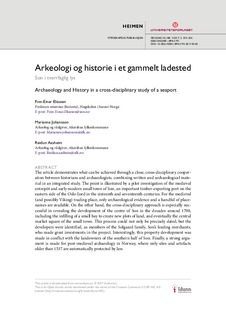Arkeologi og historie i et gammelt ladested: Son i tverrfaglig lys
Journal article, Peer reviewed
Published version
Permanent lenke
http://hdl.handle.net/11250/2500696Utgivelsesdato
2017Metadata
Vis full innførselSamlinger
Originalversjon
Heimen - Lokal og regional historie. 2017, 54 (3), 235-256. 10.18261/issn.1894-3195-2017-03-03Sammendrag
The article demonstrates what can be achieved through a close, cross-disciplinary cooperation between historians and archaeologists, combining written and archaeological material in an integrated study. The point is illustrated by a pilot investigation of the medieval entrepôt and early modern small town of Son, an important timber-exporting port on the eastern side of the Oslo fjord in the sixteenth and seventeenth centuries. For the medieval (and possibly Viking) trading-place, only archaeological evidence and a handful of place-names are available. On the other hand, the cross-disciplinary approach is especially successful in revealing the development of the centre of Son in the decades around 1700, including the infilling of a small bay to create new plots of land, and eventually the central market square of the small town. This process could not only be precisely dated, but the developers were identified, as members of the Solgaard family, Son’s leading merchants, who made great investments in the project. Interestingly, this property development was made in conflict with the landowners of the southern half of Son. Finally, a strong argument is made for post-medieval archaeology in Norway, where only sites and artefacts older than 1537 are automatically protected by law.

